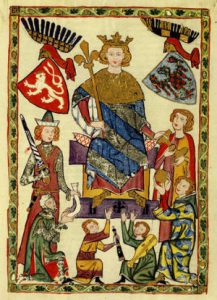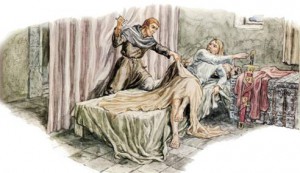Wenceslas III (Václav III): The end of a dynasty
By Tracy A. Burns
 When Bohemian King Wenceslas (Václav) III was murdered in Olomouc August 4, 1306, the male line of the legendary Přemysl dynasty, which had begun in the ninth century, came to an abrupt and tragic end. The Luxembourg clan took over Bohemia while the Piasts became rulers of Poland.
When Bohemian King Wenceslas (Václav) III was murdered in Olomouc August 4, 1306, the male line of the legendary Přemysl dynasty, which had begun in the ninth century, came to an abrupt and tragic end. The Luxembourg clan took over Bohemia while the Piasts became rulers of Poland.
The Přemyslid dynasty
According to a legend, the dynasty was born when poor farmer Přemysl the Ploughman from Stadice married Libuše, the founder of Prague and ruler of much of Bohemia, and they had three sons. While that is not a true story, in real life the family sovereigns did make significant accomplishments to the kingdom. In 1212 Holy Roman Emperor Frederick II presented Bohemian King Přemysl Otakar I with the Golden Bull of Sicily, which allowed Otakar I and his heirs officially to take on the title of king in Bohemia. The emperor no longer had to grant the approval of the Czech ruler. Otakar I encouraged Germans to colonize his realm and founded many towns – something his son and successor, Přemysl Otakar II, would continue later that century. In addition, Otakar II established the Hofburg Palace in Vienna and had numerous castles constructed. Wenceslas III’s father, Wenceslas II, was the first Přemyslid to sit on the Polish throne. The dynasty governed Hungary as well. After Wenceslas III died, the kings of the Czech lands were all descendants of foreign clans, except for Bohemian King George of Poděbrady.
Wenceslas III’s childhood
The future king of three countries was born on October 6, 1289, in Prague as a twin to his sister Anna, who died as a small child. His father Wenceslas II held the posts of King of Bohemia and Poland, and his mother hailed from the Habsburg family – Judith of Habsburg was the daughter of Rudolf I, King of the Romans. Wenceslas III had sisters named Anna (the second Anna), Eliška, Margaret (Markéta), and a half-sister, Agnes (Anežka). In Vienna in February of 1298, his father attempted to strengthen Bohemia’s relationship with Hungary when his son became engaged to Elizabeth, the daughter of Hungarian King Andrew II.
Personality
Some chroniclers state that Wenceslas III was fairly well-educated, modest, and spoke four languages, while others assert that the teenager spent too much time drinking and not enough time governing. He is often described as a reveler and a rake. He was nicknamed the “Younger King” even before he took up that position.
Hungary: A teenager’s growing pains
The teenage Wenceslas III ruled Hungary, Bohemia, and Poland for a brief period, but his time on the thrones was marked by friction with Hungary and Poland. Wenceslas II was determined to capture the Hungarian throne for his son. King Andrew II died in 1301, and Wenceslas II gave Hungarian nobles silver from Kutná Hora so his son could ascend to the Hungarian throne. Known as Ladislaus (Ladislav) V to Hungarians, Wenceslas III had a tense relationship with Hungary. Only leaders of modern Slovakia and western Hungary pledged allegiance to him as their ruler.
Wenceslas III’s rival: Charles Robert
Then, in 1303, the situation became even more complicated. Charles Robert of Anjou came into the picture. The Pope and others wanted Charles Robert to become the Hungarian king. His royal title was threatened, and Ladislaus V asked his father for help. Wenceslas II responded by invading Buda and returning to Bohemia with his son, some hostages, and the Hungarian crown. However, later Wenceslas III had second thoughts. When his father died in 1305, he relinquished his title as Hungarian king. No longer needing political power in the Hungarian lands, he also broke off his engagement to Elizabeth. In December of 1305, Otto, Duke of Lower Bavaria, became the next sovereign of Hungary, though he would sit on the throne for only a few years. In 1307 Otto was incarcerated. When he abdicated in 1308, Wenceslas III’s old rival, Charles Robert, succeeded Otto as Hungarian king.
Problems with Poland during puberty
After breaking off the engagement with Elizabeth in 1305, Wenceslas III wed Viola of Tsechen, the daughter of Mieszko I, Duke of Tsechen. They had one daughter. When his father died, Wenceslas III inherited the titles of King of Bohemia and King of Poland. He was just beginning to gather support for claiming the Polish throne when, someday after July 5, he left Prague and came to Olomouc in Moravia.
The death of Wenceslas III
 While it is not known when exactly Wenceslas III arrived in Olomouc, it is certain that on August 4, 1306, a Thursday afternoon, he was resting in the house of the former Olomouc deanery, where he was murdered. To this day the identity of the person who carried out this ghastly deed is a mystery. Wenceslas III was not even 17 years old.
While it is not known when exactly Wenceslas III arrived in Olomouc, it is certain that on August 4, 1306, a Thursday afternoon, he was resting in the house of the former Olomouc deanery, where he was murdered. To this day the identity of the person who carried out this ghastly deed is a mystery. Wenceslas III was not even 17 years old.
Theories about the murder
There are many theories concerning the identity of the assassin. Some scholars claim that the Habsburg Albert I, King of the Romans and Duke of Austria, was behind Wenceslas’ death. Others state that Ladislaus the Short, King of Poland from 1261 to 1333, sent someone to murder him. Still, others assert that one of Wenceslas’ young drinking companions killed him.
The burial of Wenceslas III
 Wenceslas III was initially buried in the crypt of Saint Václav Cathedral in Olomouc. Then, in 1326, his remains were transferred to the Zbraslav monastery, where he was interned next to his father. However, his skeleton was somehow lost.
Wenceslas III was initially buried in the crypt of Saint Václav Cathedral in Olomouc. Then, in 1326, his remains were transferred to the Zbraslav monastery, where he was interned next to his father. However, his skeleton was somehow lost.
Make way for the Luxembourgs
Hailing from Germany during the late Middle Ages, the house of Luxembourg claimed the Bohemian throne when John of Luxembourg married Přemyslid heiress Elizabeth of Bohemia in 1310. The Luxembourgs remained rulers of the Holy Roman Empire (with two interruptions) from 1308 to 1437 when they would also end their tenure as Bohemian kings.



